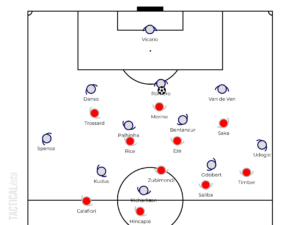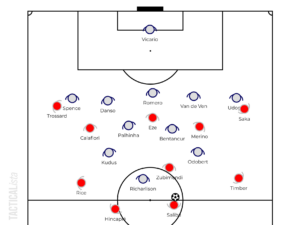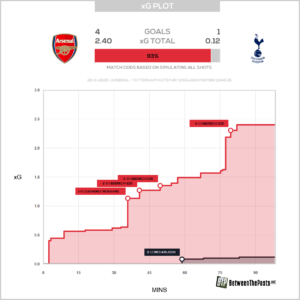Arsenal – Tottenham Hotspur: All Too Eze For Arsenal (4-1)
Eberechi Eze’s hattrick takes the headlines, but this was an outstanding team performance from Arsenal across the pitch. In the first half, they dominated the ball against a passive Spurs side, while the second half saw a display of defensive discipline to ensure a miserable day for Spurs all-round.
Tactical analysis and match report by Josh Manley.
We decided to make this article free to read. If you want to support our work, consider taking a subscription.
Mikel Arteta’s side were held to a draw at Sunderland before the international break, but that did little to dampen the mood after a truly excellent first three months of the season. Other results this weekend meant that a win in this edition of the North London Derby would send Arsenal six points clear at the top of the Premier League.
For Spurs, things have been less rosy. It’s still early in Thomas Frank’s reign, and the league position is not terrible. However, the performances, both tactically and in terms of underlying numbers, suggest that they are a team with problems.
Arsenal lined up in a 4-2-3-1 shape, with Jurriën Timber, William Saliba, Piero Hincapié, and Riccardo Calafiori in the back four. Martín Zubimendi and Declan Rice continued their central midfield partnership, with Eberechi Eze in the number ten role. Bukayo Saka and Leandro Trossard then flanked Mikel Merino up front.
Spurs meanwhile were set up in a 3-4-3 system. Kevin Danso, Cristian Romero, and Micky van de Ven were the three center-backs, while Djed Spence and Destiny Udogie played as wing-backs. João Palhinha and Rodrigo Bentancur were the central midfielders, while the front three comprised Mohammed Kudus, Richarlison, and Wilson Odobert.
Spurs surrender possession
Frank’s gameplan in the first half clearly revolved around trying to minimize perceived risk. Without the ball, they defended deep, and with the ball they often played very directly. When they won free-kicks in their own half, they would often send their center-backs forward and have goalkeeper Guglielmo Vicario kick long towards Arsenal’s box.
When they did try to play more constructively from the back, Arsenal would press high and aggressively. From their initial 4-4-1-1 defensive shape, Arsenal could transition into a 4-3-3 when pressing, getting their wingers engaged against Spurs’ wide center-backs.

Arsenal’s first-half pressing.
Eze and Rice would then be marking Spurs’ central midfielders, cutting off the immediate options for the Spurs player on the ball. An important part of Arsenal’s high pressing was also the ability of the center-backs and Zubimendi to manage the Spurs front three.
For example, with Rice pushing forward, it was important that Hincapié was able to jump out to get tight against Kudus, in order to prevent the space left behind Rice from being exploited. Zubimendi was also required to drop into the defensive line at certain points to provide cover, and did so effectively.
Arsenal also had high pressing variations where Merino or Eze would both step up onto the center-backs, along with one of the wingers – essentially jumping more into an asymmetric 4-4-2 pressing shape.
By the end of the first half, Spurs had still not managed an attempt at Arsenal’s goal, which shows the extent to which Arsenal were able to limit their attacking play in the first half.
Arsenal dismantle Spurs’ defense
Even more impressive than Arsenal’s high pressing in the first half was their possession play though. Faced with a 5-2-3 mid or low block from Spurs, Arteta’s side used their strong understanding of attacking structures and off-the-ball movement to unlock the defense and eventually go two goals up by half time.
The initial structure for Arsenal was often a 3-2-5 shape, with Timber as part of the back three, and Calafiori pushing up in the left halfspace. However, this became extremely variable, as Arsenal showed their understanding of possession principles to move fluidly between structures.
Timber would often push up on the right side as it became apparent that Spurs were unable to pressure Arsenal’s first line of buildup. Rice would often drop out to the left side to access the space outside of Kudus while Zubimendi could drift between the first and second lines of buildup as appropriate. Merino and Eze often occupied the right halfspace and number ten position respectively.

One of Arsenal’s buildup variations in the first half.
Spurs’ wing-backs were usually pinned back by Arsenal’s wingers, and Arsenal’s strong occupation of the halfspaces and number ten zone meant that Spurs’ midfield were also often pinned and unable to effectively generate pressure against Arsenal’s buildup. The center-backs seemed reticent to jump out for Spurs, as Arsenal always threatened the space in behind through their wingers and midfield runners.
Something that Arsenal did extremely well on an individual level was taking up positions that were between two or more Spurs players, rather than allowing themselves to be covered effectively by one Spurs player. Their intelligent movement to always find the pockets of space in Spurs’ structure gave Frank’s defense nightmares.
The right side was quite active in Arsenal’s buildup, with Saka being supported by Timber’s runs from deep. In the buildup to the first goal, Timber was able to get free in the right halfspace and attract the Spurs midfield to this area, before shifting the ball back to the center where Merino was free to supply the assist to Trossard.
This shifting of the ball back in from the right side towards the center was another trend. Kudus often positioned himself slightly higher than the rest of the Spurs midfield, which meant that there was space alongside Palhinha. This also became an issue in the buildup to Arsenal’s third goal early in the second half.
Arsenal’s defensive side
With the issues faced by Spurs in the first half, it was clear that changes were needed going into the second half. Frank obliged, bringing Xavi Simons on for Danso and reverting to a 4-2-3-1 formation with Simons at number ten.
Spurs tried to press more aggressively in midfield, trying to get their central midfielders engaged against Zubimendi and Rice. This led directly to Spurs’ only goal of the game, where Palhinha was able to pickpocket Zubimendi in Arsenal’s number six area before Richarlison beat David Raya with an audacious chip from long range.
This was all of the attacking joy that Spurs would get in this game though, as despite their renewed attacking intention, Arsenal showed their intensity and organization against the ball to prevent the away side from building any attacking momentum. Arsenal’s counter-attacks were a bigger attacking threat than Spurs’ possession phases.

Arsenal had no problem defending from their own half in a 4-4-2 shape.
When they had to defend deeper, Arsenal used a 4-4-2 shape. The wide players did not come extremely narrow, but the close support of Eze and Merino and their willingness to press backwards meant that Arsenal did not suffer too much from a lack of compactness in the center.
One of Arsenal’s outstanding abilities is their ability to jump forward from an initial mid-low block and force backwards passes from the opponent. This allows Arsenal to jump back into high pressing and maintain a high degree of game control without the ball.
Arsenal were still able to use their 4-3-3 high pressing shape after Spurs’ change of shape, with the wingers now pressing Spurs’ fullbacks and center-backs situationally, while Arsenal’s midfield went man-to-man against Spurs’.
Eze capped off a dream performance with a third goal in the final fifteen minutes, once again demonstrating outstanding composure at the edge of the Spurs box, as he had done throughout the game.

Takeaways
Arsenal put out a statement here as the Premier League season begins to move into a crucial winter period. On an individual and collective level, they showed their excellence on both sides of the ball – able to dominate in possession in the first half and keep up the intensity without the ball in the second half.
There are issues to address for Frank at Spurs, who offered very little in this match. They defended passively in the first half and had no way of progressing the ball apart from long kicks from the goalkeeper. In the second half they showed more intent but still had little in the way of viable ball progression methods – an issue that has been present throughout the season so far.
Use the arrows to scroll through all available match plots. Click to enlarge.
Check the match plots page for plots of other matches.




Comments